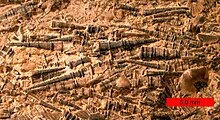| Tentaculita Temporal range: Early Ordovician to Middle Jurassic (Vinn 2010) | |
|---|---|
 | |
| Tentaculitids from the Devonian of Maryland. | |
| Scientific classification | |
| Domain: | Eukaryota |
| Kingdom: | Animalia |
| Clade: | Lophophorata |
| Class: | † Tentaculita Boucek, 1964 |
| Taxa of uncertain placement | |
Tentaculita is an extinct class of lophophorates ranging from the Early Ordovician to the Middle Jurassic. They were suspension feeders with a near worldwide distribution. For a more thorough discussion, see Tentaculites .
Contents
The presence of perforate septa and "septal necks" has been used to argue for a cephalopod affinity, whereas the shell microstructure, notably the presence of punctae, points to a brachiopod relationship, [5] and preserved musculature suggests a relationship with bryozoans. [6]